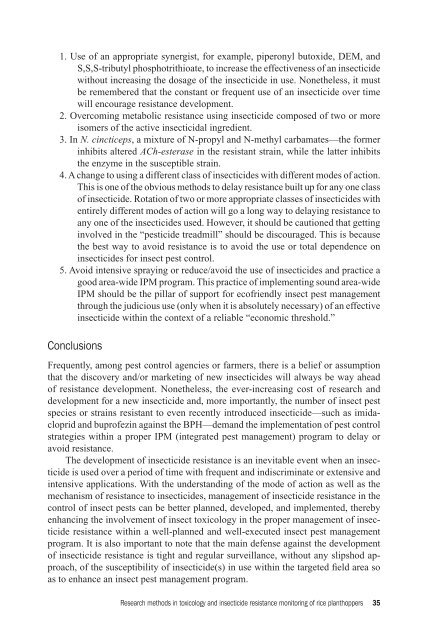Research Methods in Toxicology and Insecticide Resistance ...
Research Methods in Toxicology and Insecticide Resistance ...
Research Methods in Toxicology and Insecticide Resistance ...
Create successful ePaper yourself
Turn your PDF publications into a flip-book with our unique Google optimized e-Paper software.
1. Use of an appropriate synergist, for example, piperonyl butoxide, DEM, <strong>and</strong><br />
S,S,S-tributyl phosphotrithioate, to <strong>in</strong>crease the effectiveness of an <strong>in</strong>secticide<br />
without <strong>in</strong>creas<strong>in</strong>g the dosage of the <strong>in</strong>secticide <strong>in</strong> use. Nonetheless, it must<br />
be remembered that the constant or frequent use of an <strong>in</strong>secticide over time<br />
will encourage resistance development.<br />
2. Overcom<strong>in</strong>g metabolic resistance us<strong>in</strong>g <strong>in</strong>secticide composed of two or more<br />
isomers of the active <strong>in</strong>secticidal <strong>in</strong>gredient.<br />
3. In N. c<strong>in</strong>cticeps, a mixture of N-propyl <strong>and</strong> N-methyl carbamates—the former<br />
<strong>in</strong>hibits altered ACh-esterase <strong>in</strong> the resistant stra<strong>in</strong>, while the latter <strong>in</strong>hibits<br />
the enzyme <strong>in</strong> the susceptible stra<strong>in</strong>.<br />
4. A change to us<strong>in</strong>g a different class of <strong>in</strong>secticides with different modes of action.<br />
This is one of the obvious methods to delay resistance built up for any one class<br />
of <strong>in</strong>secticide. Rotation of two or more appropriate classes of <strong>in</strong>secticides with<br />
entirely different modes of action will go a long way to delay<strong>in</strong>g resistance to<br />
any one of the <strong>in</strong>secticides used. However, it should be cautioned that gett<strong>in</strong>g<br />
<strong>in</strong>volved <strong>in</strong> the “pesticide treadmill” should be discouraged. This is because<br />
the best way to avoid resistance is to avoid the use or total dependence on<br />
<strong>in</strong>secticides for <strong>in</strong>sect pest control.<br />
5. Avoid <strong>in</strong>tensive spray<strong>in</strong>g or reduce/avoid the use of <strong>in</strong>secticides <strong>and</strong> practice a<br />
good area-wide IPM program. This practice of implement<strong>in</strong>g sound area-wide<br />
IPM should be the pillar of support for ecofriendly <strong>in</strong>sect pest management<br />
through the judicious use (only when it is absolutely necessary) of an effective<br />
<strong>in</strong>secticide with<strong>in</strong> the context of a reliable “economic threshold.”<br />
Conclusions<br />
Frequently, among pest control agencies or farmers, there is a belief or assumption<br />
that the discovery <strong>and</strong>/or market<strong>in</strong>g of new <strong>in</strong>secticides will always be way ahead<br />
of resistance development. Nonetheless, the ever-<strong>in</strong>creas<strong>in</strong>g cost of research <strong>and</strong><br />
development for a new <strong>in</strong>secticide <strong>and</strong>, more importantly, the number of <strong>in</strong>sect pest<br />
species or stra<strong>in</strong>s resistant to even recently <strong>in</strong>troduced <strong>in</strong>secticide—such as imidacloprid<br />
<strong>and</strong> buprofez<strong>in</strong> aga<strong>in</strong>st the BPH—dem<strong>and</strong> the implementation of pest control<br />
strategies with<strong>in</strong> a proper IPM (<strong>in</strong>tegrated pest management) program to delay or<br />
avoid resistance.<br />
The development of <strong>in</strong>secticide resistance is an <strong>in</strong>evitable event when an <strong>in</strong>secticide<br />
is used over a period of time with frequent <strong>and</strong> <strong>in</strong>discrim<strong>in</strong>ate or extensive <strong>and</strong><br />
<strong>in</strong>tensive applications. With the underst<strong>and</strong><strong>in</strong>g of the mode of action as well as the<br />
mechanism of resistance to <strong>in</strong>secticides, management of <strong>in</strong>secticide resistance <strong>in</strong> the<br />
control of <strong>in</strong>sect pests can be better planned, developed, <strong>and</strong> implemented, thereby<br />
enhanc<strong>in</strong>g the <strong>in</strong>volvement of <strong>in</strong>sect toxicology <strong>in</strong> the proper management of <strong>in</strong>secticide<br />
resistance with<strong>in</strong> a well-planned <strong>and</strong> well-executed <strong>in</strong>sect pest management<br />
program. It is also important to note that the ma<strong>in</strong> defense aga<strong>in</strong>st the development<br />
of <strong>in</strong>secticide resistance is tight <strong>and</strong> regular surveillance, without any slipshod approach,<br />
of the susceptibility of <strong>in</strong>secticide(s) <strong>in</strong> use with<strong>in</strong> the targeted fi eld area so<br />
as to enhance an <strong>in</strong>sect pest management program.<br />
<strong>Research</strong> methods <strong>in</strong> toxicology <strong>and</strong> <strong>in</strong>secticide resistance monitor<strong>in</strong>g of rice planthoppers 35

















